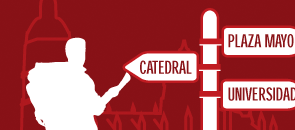Salamanca in 2 days
In addition to being able to move around and discover the city in depth, spending two days in Salamanca provides visitors an opportunity to enjoy the nightlife and the wonderful night-time venues. The street is always filled with people, in all seasons, at any time of the year. And the night time venues started a popular trend in Spain thanks to their wonderful setting and their young and fun atmosphere.
Day one
In the morning, enjoy a pleasant stroll around the Plaza Mayor and gaze at the reliefs of its medallions. Then the University, where you have the opportunity to visit some of the singular settings, such as the old library, the cloisters and the Cielo de Salamanca (Salamanca Sky).
Opposite the Casa de las Conchas, nowadays a public library, is the Pontifical University and the La Clerecía Church; from the towers of the Clerecía (Ministry in English) you get wonderful panoramic views of the city. The area is busy with a multitude of students as they make their way to the faculties that are located in the city centre. Cafés and bookshops are abundant.
A quick break to eat. Choose from any of the restaurants that offer charbroiled meats and roasts, traditional dishes, and who could forget the Guijuelo cured meats and the Arribes cheeses to get those taste-buds watering. In certain establishments, you can try farinato, a traditional sausage dish from Ciudad Rodrigo, served with fried eggs, or with a modern twist, served with scrambled egg, croquettes or mousse.
Continuing with the walk, we come to the cathedrals (access to the new cathedral is free). We finish off the visit by climbing the Cathedral’s medieval towers, en route taking in the Ieronimus exhibition. It is one of the essential places to visit because it offers some spectacular views of the cathedrals and churches and the city itself.
Some local pastries, a slice of cake, or some chocolate, and in the summer ice-cream, in the winter chocolate con churros (hot chocolate served with fritters)…, any of the above will give us the energy we need to carry on with our walk.
We discover more and more of the city. The Automotive Museum and the Flour Mill Museum are located just next to the river. The latter is located just next to the Casino del Tormes; the terrace of its restaurant is open to the public during the summer months.
For supper, we have the choice of two routes that take us to areas with plentiful tapas bars: both areas are vibrant: the first in the city centre, in and around the Plaza Mayor, and the second, in the northern part of the city, the Van Dyck district, frequented by the younger generation.
Afterwards, the more laid back amongst you can take a moonlit walk through the city centre and enjoy the illuminated buildings. The rest can enjoy the city’s party scene, experiencing first hand Salamanca’s renowned nightlife. There are a number of areas: Gran Vía, Calle Bordadores, Plaza de la Reina and for the more alternative crowd, Plaza de San Justo and Calle Varillas.
Day two
After a wonderful breakfast at any of the terraces in the historic centre, we start the day heading towards the San Esteban Convent, a Dominican church where Columbus sought favour with the Catholic Kings. Opposite is the Las Dueñas Convent, with its breathtaking cloister. Two legendary sites comes into view along Calle San Pablo: the mysterious Cueva de Salamanca, where, according to legend, students studied the dark arts, fortune-telling and magic; and the Patio de la Salina (former salt store).
Any shopping needed can be done in the centre, in and around Calles Zamora and Toro; as well as along Calle María Auxiliadora. If you are looking for meat, cold meats and traditional foodstuffs, then why not head to the Central Market, a modernist building that is well worth investigating.
If you are looking for somewhere to eat, why not choose one of the city’s more avant-garde restaurants, with their signature dishes, creative and using only top quality ingredients.
In the afternoon we can visit Art Nouveau & Art Deco Museum, housed in an impressive modernist building, or perhaps the Domus Artium, home to the contemporary art centre and formerly a provincial prison. We continue with a visit to some of the city’s small churches, stopping off at the famous Café Novelty, steeped in history and frequented by orators, farmers, and students alike… In summer, there are long queues as people line up to try some of their renowned ice creams.
Or you could discover the city another way: why not on a bike ride, following the bike lane along the river, the university campus and some of the city’s other districts; as well as the city centre. At the Espacio joven building (Calle Arco no. 11 mezzanine www.amigosdelabici.es ) you can rent bikes.
In the summer months, why not enjoy some theatre, live music, magic acts, flamenco or film at any of the different cultural venues across the city that are part of the Plazas y Patios (Squares and Courtyards) cultural programme. And if you are going to be here during the first fortnight of June, you can attend one of the many events being held as part of the Castile-and-León International Arts Festival (FIACyL).
And for supper… Throughout the year, there are jornadas gastronómicas (food festivals) where you can savour some exquisite seasonal dishes.











